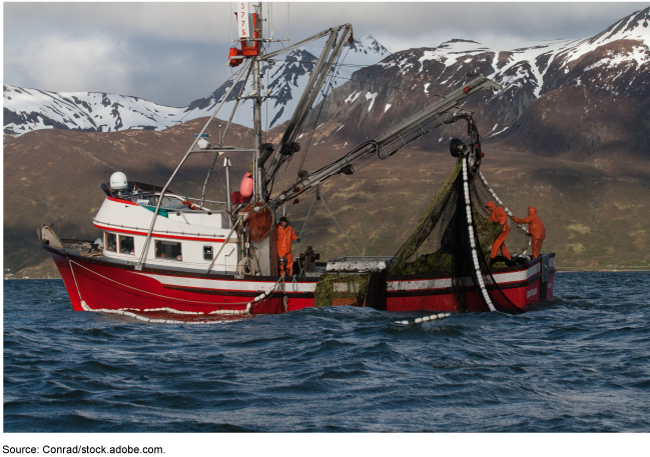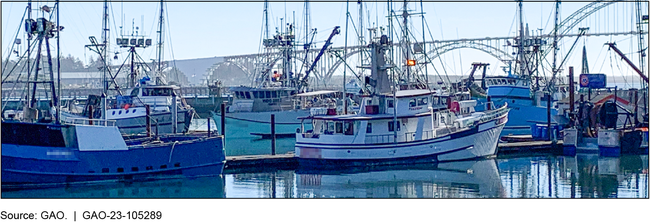Coast Guard: Additional Actions Needed to Improve Commercial Fishing Vessel Safety Efforts
Fast Facts
To improve safety in the extremely dangerous commercial fishing industry, Coast Guard examines fishing vessels' documents and safety equipment, and conducts outreach to fishers, among other efforts.
But, Coast Guard hasn't fully implemented 17 of 22 statutory requirements to improve commercial fishing vessel safety. For example, Coast Guard hasn't developed a training program for commercial fishers or re-established an advisory committee on industry safety issues. In addition, Coast Guard doesn't have a detailed plan to guide their efforts to fully implement the outstanding statutory requirements.
Our recommendations address this and more.

Highlights
What GAO Found
Coast Guard efforts to promote commercial fishing vessel safety include conducting dockside exams, engaging with industry, and collaborating with other federal agencies. A dockside exam includes a review of a vessel's documents and safety equipment. Vessels that successfully complete an exam receive a 2-year safety decal from the Coast Guard. In addition, the agency engages with industry through safety trainings and policy letters, among other efforts. The Coast Guard also collaborates with other federal agencies, such as the National Marine Fisheries Service, by sharing accident data and supporting vessel safety research.
Commercial Fishing Vessels in Newport, Oregon

The Coast Guard fully implemented five of 22 key statutory requirements related to various aspects of commercial fishing vessel safety (e.g., equipment, training, exams) enacted from fiscal years 2011 through 2021. However, it has either partially or not implemented 17 requirements. One requirement that the Coast Guard does not intend to implement is to develop alternate safety standards for older fishing vessels, which account for almost 80 percent of fishing vessel losses. The Coast Guard stated it does not have the authority to address the requirement to develop alternate safety standards for older fishing vessels. However, based on GAO's review of the applicable statutory provisions, the Coast Guard does have the authority to implement this requirement. In June 2016, the Coast Guard issued a proposed rule intended to address nine of the other 16 outstanding requirements. However, as of August 2022, the rule had not been finalized, and the Coast Guard had no detailed plan for implementing these requirements. Developing and implementing alternate safety standards for older vessels and developing a plan with time frames for implementing the other 16 requirements would help to address the Coast Guard's statutory responsibilities and support efforts to prevent fishing vessel losses and related fatalities.
The Coast Guard has established strategic goals and performance goals for its commercial fishing vessel safety program. However, it has not fully incorporated other key performance management practices, such as establishing performance goals that fully address all aspects of its strategic goals, setting realistic targets for its performance goals, and using performance data to assess progress towards program goals. Fully incorporating such practices could help the Coast Guard better assess program performance and address any performance issues.
Why GAO Did This Study
Commercial fishing has one of the highest industry death rates in the U.S., according to the U.S. Bureau of Labor Statistics. Since fiscal year 2011, multiple commercial fishing vessel safety requirements have been enacted. As the principal federal agency for ensuring marine safety, the U.S. Coast Guard is responsible for implementing statutory requirements related to fishing vessel safety.
GAO reviewed the Coast Guard's commercial fishing vessel safety efforts as a follow-on to other GAO work to address a provision in statute. This report examines Coast Guard efforts to (1) improve commercial fishing vessel safety; (2) implement related key statutory requirements enacted from fiscal years 2011 through 2021; and (3) incorporate key performance assessment steps for its commercial fishing vessel safety program.
To address these objectives, GAO reviewed relevant laws, as well as Coast Guard documentation and data on its efforts to improve fishing vessel safety. GAO also observed vessel exams, and interviewed Coast Guard headquarters and field-based officials.
Recommendations
GAO is making six recommendations to the Coast Guard, including to implement alternate safety standards for older vessels, develop a plan with time frames to implement the other outstanding statutory requirements, and fully incorporate key performance management practices. DHS concurred with five of six recommendations. GAO maintains that the findings in the report support all of the recommendations.
Recommendations for Executive Action
| Agency Affected | Recommendation | Status |
|---|---|---|
| United States Coast Guard | The Commandant of the Coast Guard should ensure that the Fishing Vessel Safety Division, in coordination with the Office of Maritime Law Enforcement, clarifies and documents the agency's policy on the enforcement of the dockside exam requirement during at-sea boardings of commercial fishing vessels. (Recommendation 1) |
In early May 2023, Coast Guard officials reported that the Fishing Vessel Safety Division was working with the Office of Maritime Law Enforcement to clarify and update program direction to field units related to the enforcement of the dockside exam requirement during at-sea boardings of commercial fishing vessels. The Coast Guard then finalized and issued a policy letter containing guidance on the enforcement of the exam requirement during at-sea boardings in late May 2023. As a result, we consider this recommendation closed and implemented.
|
| United States Coast Guard | The Commandant of the Coast Guard should ensure that the Assistant Commandant for Prevention Policy develops and implements an alternate safety compliance program, as required by law. (Recommendation 2) |
In November 2022, we reported that the Coast Guard did not intend to implement the statutory requirement to establish an alternate safety compliance program for certain older commercial fishing vessels. We recommended that the Commandant of the Coast Guard ensure that the Assistant Commandant for Prevention Policy develops and implements an alternate safety compliance program, as required by law. The Coast Guard did not concur with our recommendation. As stated in our November 2022 report, the Coast Guard determined that it did not have the legal foundation to implement an alternate safety compliance program. We disagreed with the agency's determination and maintained that the Coast Guard should implement the program. However, in December 2022, the James M. Inhofe National Defense Authorization Act of Fiscal Year 2023 repealed the provision requiring the Coast Guard to implement an alternate safety compliance program. [Pub. L. No. 117-263, div. K, title CXV, § 11509(a)(3), 136 Stat. 4137 (2022)]. As a result, we are closing our recommendation that the Coast Guard implement the program as it is no longer valid.
|
| United States Coast Guard | The Commandant of the Coast Guard should ensure that the Assistant Commandant for Prevention Policy develops a plan with time frames and interim milestones to fully implement the other 16 outstanding statutory requirements for commercial fishing vessel safety, including issuing regulations. (Recommendation 3) |
As of May 2025, the Coast Guard had implemented two of the 16 outstanding statutory requirements and provided estimated completion dates for 11. Of the 11 outstanding statutory requirements with completion dates, Coast Guard estimated that two will be completed in February 2026 and the nine other requirements will be completed in April 2026 when the current fishing vessel regulatory project-RIN 1625-AB85-is published as a final rule. The Coast Guard did not provide timeframes or milestones for three outstanding statutory requirements. Coast Guard officials stated their intent to provide timeframes and milestones for these outstanding requirements after the current regulatory project is published as a final rule. We continue to monitor the Coast Guard's progress on implementing this recommendation.
|
| United States Coast Guard | The Commandant of the Coast Guard should ensure that the Fishing Vessel Safety Division establishes performance goals for the commercial fishing vessel safety program that fully address all aspects of the program's strategic goals. (Recommendation 4) |
In February 2024, the Coast Guard established six performance goals for the commercial fishing vessel safety program. However, the six performance goals do not fully address all aspects of the program's strategic goals. Specifically, as of May 2025, the Coast Guard has not established performance goals for the program that are related to reducing environmental damage, conducting at-sea boardings, or increasing the safety of high-risk vessels-key aspects of the commercial fishing vessel safety program's strategic goals. We continue to monitor the Coast Guard's progress on implementing this recommendation.
|
| United States Coast Guard | The Commandant of the Coast Guard should ensure that the Fishing Vessel Safety Division sets realistic targets for the commercial fishing vessel safety program's performance goals. (Recommendation 5) |
In February 2024, the Coast Guard set targets for the commercial fishing vessel safety program's six performance goals. We found that some of these targets were realistic because they reflected past performance and will be adjusted based on actual results. For example, for 2024, the Coast Guard set a target of 5,000 dockside exams conducted and 5,000 safety decals issued. In 2023, the Coast Guard conducted roughly 5,300 dockside exams and issued almost 4,100 safety decals. The Coast Guard stated that it will measure performance by analyzing actual numbers against the targets and that a 10 percent variance warrants consideration to adjust the next year's targets. However, the Coast Guard did not set realistic targets for its performance goals related to commercial fishing vessel losses and fatalities. The 2024 target for both goals was set at zero, which is the same target we evaluated in our November 2022 report. In May 2025, Coast Guard officials said they do not intend to change the target for these goals because the only acceptable number of vessel losses or fatalities in a given year is zero. We continue to believe this recommendation is important because realistic performance targets would enable Coast Guard to determine whether the commercial fishing vessel safety program's various efforts are achieving their intended near-term results, to identify areas for improvement if targets are not met, and to assess progress towards achieving a significant reduction in commercial fishing vessel losses and fatalities.
|
| United States Coast Guard | The Commandant of the Coast Guard should ensure that the Fishing Vessel Safety Division uses performance data to assess progress towards the commercial fishing vessel safety program's goals on a regular basis. (Recommendation 6) |
In February 2024, officials from the Coast Guard's commercial fishing vessel safety program said that previous year performance will be assessed in January of the current year. In June 2025, officials provided agency guidance for assessing each of the program's six performance goals. We continue to monitor the Coast Guard's progress on implementing this recommendation as it develops performance goals for the program that are related to reducing environmental damage, conducting at-sea boardings, and increasing the safety of high-risk vessels.
|
